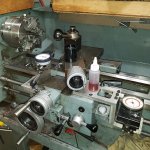Pete Wass
Well-known member
Finally got my new to me lathe running. This lathe had no collets with it so after some looking around I decided on a set of ER 40's. I must say, so far, everything seems to be great. My lathe has a D type spindle in it so I bought a corresponding collet holder and a set of collets along with an MT3 holder for the tail stock.
Used it yesterday to hold a barrel so that I could polish it and, WOW, Impressive, to say the least. I think I am fortunate in that the spindle end holder only runs out about a tenth. ( yes, I have an indicator that will read a tenth ) So, great! I am going to upgrade the screws and nuts in the cross slide and compound and I should be in Fat City. Perhaps I will do a DRO kit first though.
) So, great! I am going to upgrade the screws and nuts in the cross slide and compound and I should be in Fat City. Perhaps I will do a DRO kit first though.
Pete
Used it yesterday to hold a barrel so that I could polish it and, WOW, Impressive, to say the least. I think I am fortunate in that the spindle end holder only runs out about a tenth. ( yes, I have an indicator that will read a tenth
Pete





